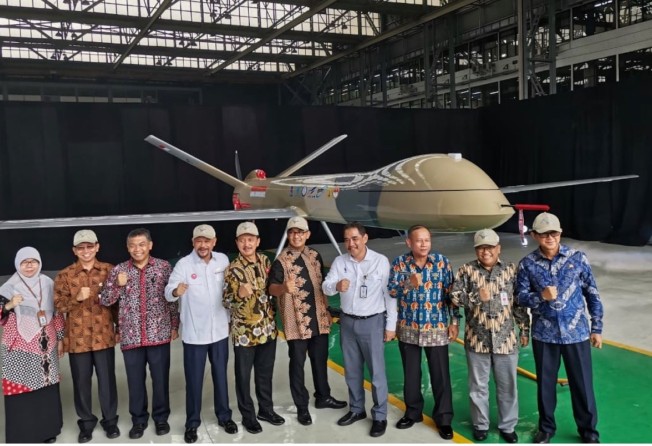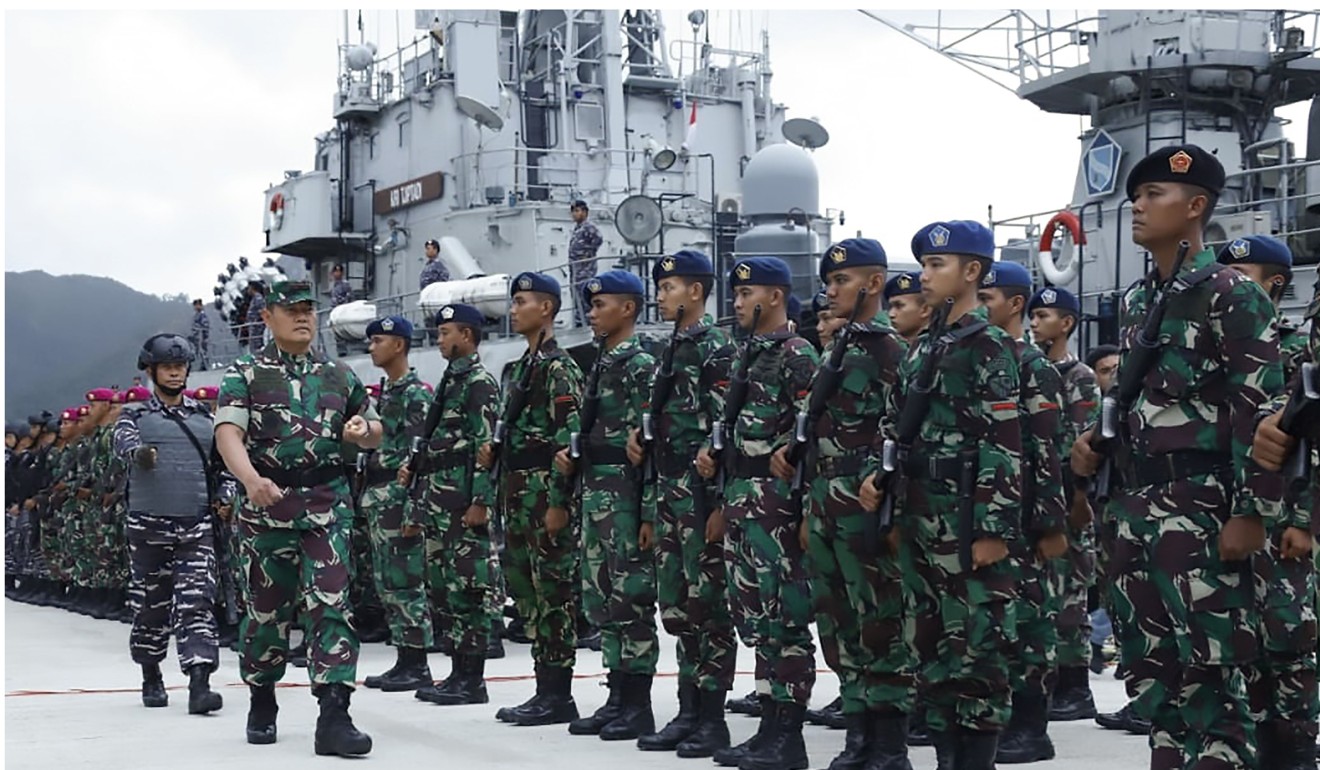View this post on InstagramA post shared by PT Dirgantara Indonesia (@officialptdi) on
Indonesia unveils new military drone as feud over South China Sea incursions escalates
- Indonesia has protested to Beijing over continued illegal fishing and the presence of China’s coastguard off its Natuna Islands
- A military analyst has questioned why Indonesia is touting a domestic aerial drone when it could have bought one from China for much less

In normal times, the unveiling of a missile-capable military drone by Indonesia’s main domestic weapons producer would not raise many eyebrows.
But the fact that the roll-out of a prototype of its MALE unmanned aerial vehicle, or UAV, came on the same day that Jakarta filed a diplomatic protest with Beijing caused a stir, even if unintentionally.
Indonesia last week protested to Beijing over alleged illegal fishing and the presence of China’s coastguard in its maritime exclusive economic zone off its Natuna Islands last month.
On Sunday, the Indonesian military said Chinese vessels remain in the area, despite the diplomatic protest. The Jakarta Post reported that the vessels, accompanied by Chinese coastguard vessels, were seen catching fish about 200km from Natuna. Two Indonesian warships were deployed to drive them out of the area, but Chinese officials reportedly said the ships were performing “routine” activities to assert China’s rights in the nearby Spratly Islands.
On Monday, an official said Indonesia was “not at war” with China, but would not tolerate border violations by any country.
“A foreign country can’t enter our territory even an inch without the government’s approval,” the coordinating minister for political, legal and security affairs, Mohammad Mahfud, told reporters.
“We are not at war, we are simply protecting our sovereignty. But there’s no negotiation because the area is ours and it’s final under international law,” he said.

Indonesia’s foreign ministry and lawmakers began going on the offensive last week, resurrecting the ghosts of a series of maritime skirmishes with China in 2016 when there was a tense period of aggressive behaviour by Beijing in asserting its sovereignty over the vast majority of the South China Sea at the expense of its Southeast Asian neighbours.
One of the 2016 incidents involved a Chinese coastguard vessel ramming a seized Chinese fishing boat to free it from the Indonesian government boat that was towing it.
“Between 2016 and now, there were some small-scale incidents. I think it’s fair to say this one’s an escalation compared to the last few years,” said Evan A. Laksmana, a senior researcher specialising in military affairs at the Centre for Strategic and International Studies in Jakarta.
Laksmana said that while the roll-out of the Indonesian drone prototype by weapons producer PT Dirgantara Indonesia was not a response to the latest incident as it had been scheduled for weeks, “it’s really hard not to see a power projection when you see fishing vessels being escorted by the Chinese coastguard. We’ve been sending diplomatic protests, we’ve called in ambassadors, so there is a lot of push by Indonesia’s maritime agencies to push the foreign ministry to take a harder line”.
Two prototypes of the MALE UAV will undergo extensive testing throughout 2020. According to officials at Dirgantara, the final product will be weapons-capable, including having the ability to carry air-to-ground missiles, and can remain operational for more than 24 straight hours.
Officials said the UAV’s uses would include tracking forest fires, smuggling and piracy – but also noted that the drone would be part of efforts to protect Indonesia’s territorial sovereignty.
Despite being one of its biggest investors and trading partners, Jakarta is wary of Beijing’s efforts to assert control over waters within Indonesia’s exclusive economic zone that have oil and natural gas reserves as well as fish stocks. For decades, Indonesia’s official policy had been that it is not a party to any territorial disputes with China in the South China Sea, unlike its regional neighbours Brunei, Malaysia, the Philippines and Vietnam. Last month, Malaysia submitted a notice to the United Nations declaring its sovereignty over maritime territory claimed by China.
After the third skirmish with Indonesia in 2016, China’s Ministry of Foreign Affairs claimed for the first time that its controversial “nine-dash line” included “traditional fishing grounds” within Indonesia’s exclusive economic zone. Jakarta responded by stationing additional military personnel to the islands and renamed the waters off it as the North Natuna Sea, to reinforce its claim.
Things mostly quieted down – at least publicly – until this latest incident, believed to have taken place sometime in mid-to-late December. Indonesia has since announced increased naval patrols in the area, likely to deflect domestic political pressure after grumblings from lawmakers.

In a December 2016 report, Aaron Connelly, a senior researcher and South China Sea expert with the Lowy Institute in Sydney, noted that Indonesian President Joko Widodo had moved from a strategy of peace “to one primarily focused on protecting its own interests around the Natuna Islands while not antagonising China”, in particular given Beijing’s infrastructure investments across Indonesia.
More than three years later, that uncertain strategy remains in play.
“I don’t think much has changed,” said Connelly, now a research fellow with the International Institute of Strategic Studies in Singapore.
Indonesia desperately needs to resource its navy and coastguard, which after years, seems to finally be standing up
So what can Indonesia do? Not much, according to analysts. Zachary Abuza, a professor at the National War College in Washington, DC, said Indonesia “has always had an appalling lack of maritime domain awareness” and continues to search for land-based solutions to maritime security threats, given the dominance of the country’s army throughout the decades.
“The normal Indonesian response to incursions around Natuna is to deploy more troops to the island, or land-based Apache helicopters which will rust out fairly quickly in a maritime environment,” he said. “Indonesia desperately needs to resource its navy and coastguard, which after years, seems to finally be standing up.”

Yohanes Sulaiman, an Indonesian military analyst and university lecturer, questioned why Indonesia would even tout a domestic aerial drone given that its military was keen on buying Chinese-made CH-4 Rainbow drones from China.
“We are years away from making ours operational. The US version is very expensive, and the Americans don’t give bribes or kickbacks. And the Chinese were selling it cheaply to them,” he said.
Regarding the Indonesian version, he said: “So what kind of engine is it, what’s inside of it? The most important thing is the technology.”
Asked if he thought Indonesia could produce a weapons-capable UAV to protect its territory in the South China Sea, Sulaiman said: “I’ll take it with a grain of salt.”
Additional reporting by dpa